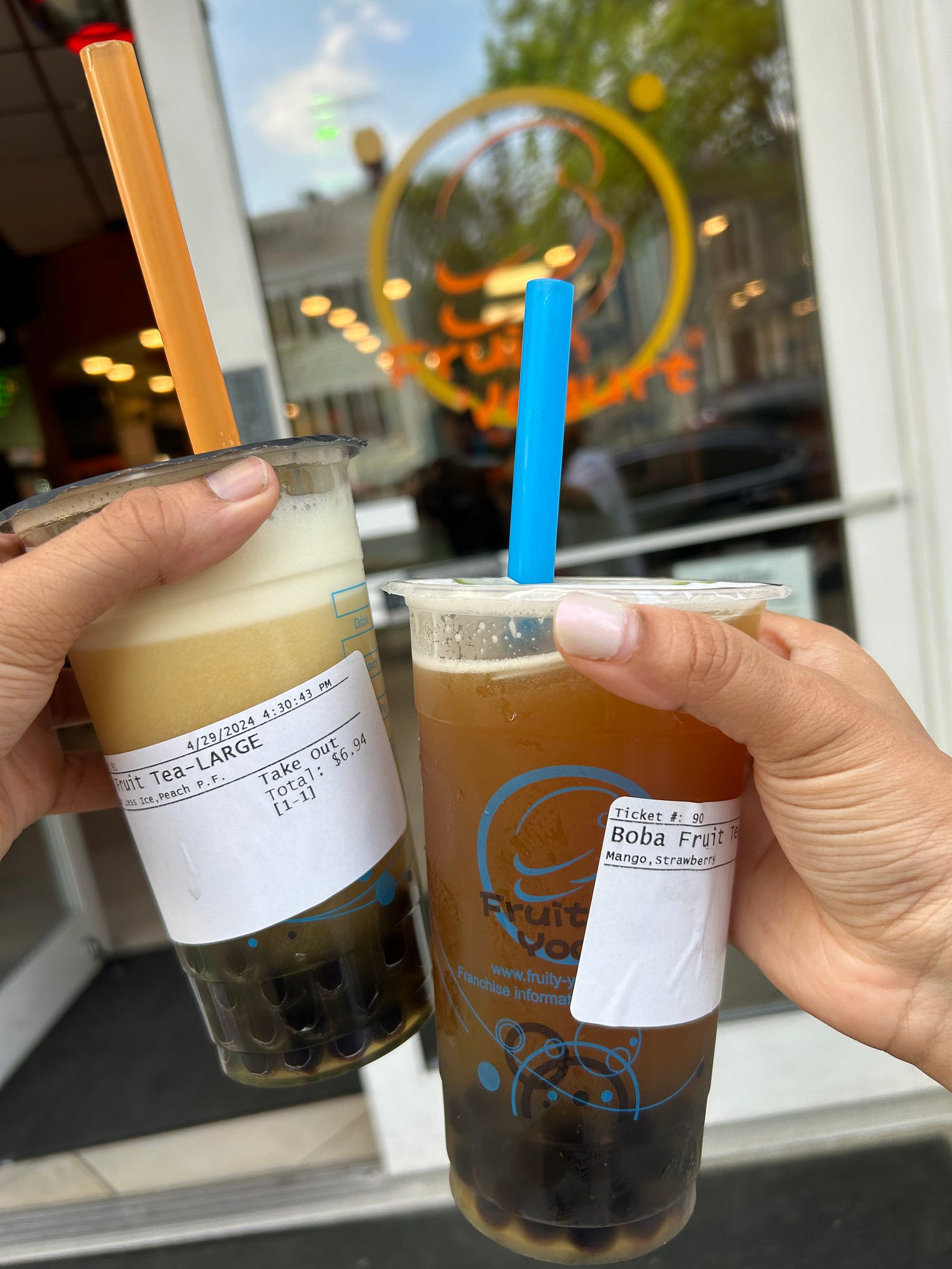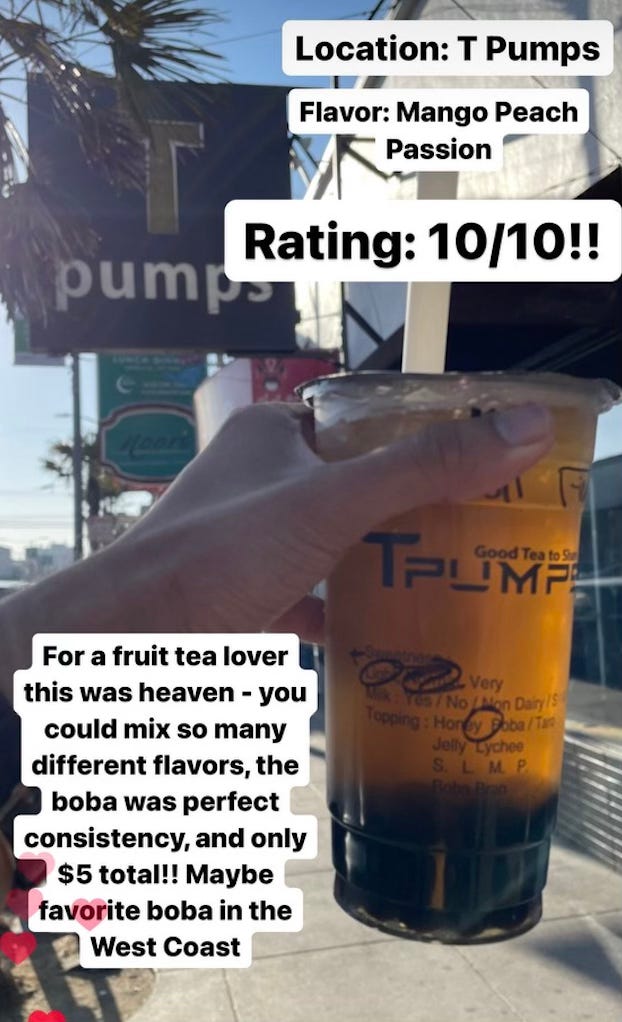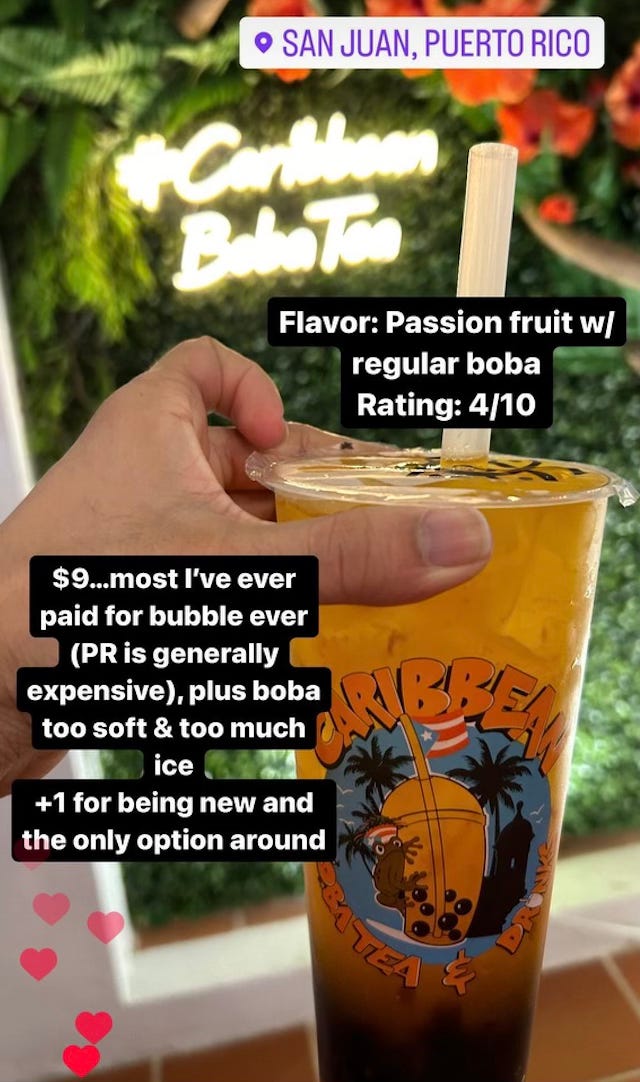Bubble Tea and Me
A Journey into my Tapioca Craving
Like my last story, let’s go back to sixth grade. The summer before, my dad shared a grand new idea. “Beta, you already speak English and Hindi. If you learn Chinese, you could talk to over half the world!” Great idea, poor execution.
I stumbled through many years of Chinese class, and wish I had more to show for it — but I did pick up something that stuck with me. During our first Lunar New Year celebrations, our Chinese teacher brought us this drink I’d never heard of. I made the rookie mistake of breaking the plastic with the dull side of the straw, and it blew up all over me. But whatever was left in my cup intrigued me.

Over the past fourteen years, I’ve had bubble tea (or boba) a couple hundred times, on four continents, and spent at least a thousand dollars on it.1 I’ve served it at my birthday parties, I’ve written about it in college applications (those schools did well to reject me), and I even made it the theme of my high school graduation speech contest (luckily for my class, I came second.)
To fill my boba craving during COVID, I bought tapioca pearls from the Asian supermarket and made it at home. When traveling in Southeast Asia during summer 2022, I had bubble tea every day, and began to post ratings of each (which I still continue). I had so much bubble tea that my teeth got stained. Sitting embarrassedly in my dentist’s chair, I had to finally ask myself the question: Why am I so obsessed with bubble tea?

My personal obsession has followed and benefitted from bubble tea’s rapid global growth. For example, leading bubble tea chain Kung Fu Tea was founded in 2010 — the year I first tried bubble tea — and now has 440+ locations globally.2 You can likely find bubble tea in every major city in Asia, North America, and increasingly the rest of the world. There are now even bubble tea trucks on Washington D.C.’s National Mall (nothing screams mainstream louder).
But while there are many reasons for bubble tea’s growth, none fully explains my own obsession.

One primary reason is the rise of “boba culture,” the popularity of bubble tea as a social activity amongst young Asian Americans in college towns and cities.3 Indeed, my first forays into bubble tea were with high school friends on Nassau Street in Princeton, which continued with college friends on Wisconsin Avenue in Georgetown. But now, some hangouts are just excuses to get bubble tea. I get it when I’m studying, or in a new city, or it’s a moderately warm day. And if I can’t convince a friend, I have no problem getting it by myself.
Bubble tea is also popular because it’s uniquely adaptable. You can pick the tea, fruit/milk, topping, ice level, sugar level, and even temperature. Two people can get bubble tea and have wildly different experiences. But I might as well not know this. Almost every time, I get mango or passionfruit with green tea, regular boba, 50% ice, and 50% sugar.
Bubble tea has other advantages. It’s easy to carry, save for later, or enjoy over an afternoon. But I usually inhale it so fast that I’m done right after leaving the store.

Honestly, if I first tried bubble tea today, I might not like it: the unnecessary sugar, calories, and single-use plastic might deter me. But I also wouldn’t subscribe to Amazing Spider-Man comics today, and yet I excitedly read every issue that comes in the mail. If I started watching the Premier League today, I maybe wouldn’t pick Manchester United, but I still go to the DC supporters bar to watch every game I can.
At some point, these activities became identities. Delight or thrill became comfort and satisfaction. I do them not to chase a feeling, but because I feel like I’m being me. Dragging others to a bubble tea store or United game is my way of sharing who I am.
Many of us have these “holdover identities” — remnants from past versions of ourselves. It’s good to know how these identities developed, and once in a while checking in with all your selves. Sometimes, they might be preventing other parts of you from growing. But for all my love of productivity and efficiency, some holdover identities feel worth holding onto.
This Tuesday was National Bubble Tea Day, and D.C.’s erratic yet steadily warming weather means that boba season has truly arrived. I’ll probably stick to 50% sugar to spare my teeth, but maybe I’ll try a new flavor, chew slowly, and see if I can become obsessed all over again.
While versions of the drink have existed for centuries, modern bubble tea was invented in Taiwan in the 1980s. The “classic” is taro milk tea with boba, which are tapioca pearls soaked in sugar.
https://www.kungfutea.com/franchise
“The Rise (and Stall) of the Boba Generation”https://www.eater.com/2019/11/5/20942192/bubble-tea-boba-asian-american-diaspora


Very well written Siddharth, I like the way you structured it and paced it. "Holdover identities" was my favorite part. Keep writing:)